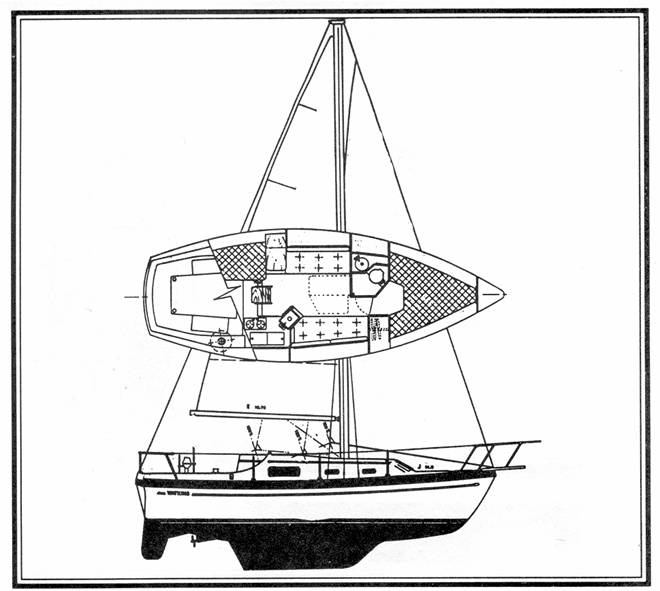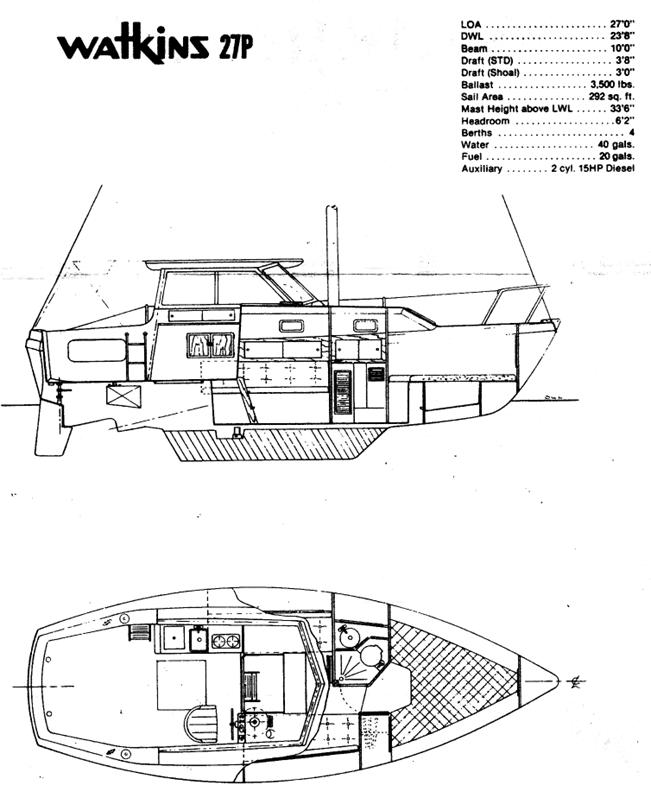|
W A T K I N S W 2 7 / W 2 7 P |
D E S I G N & H I S T O R YThe W27 was the most popular and longest running model made by Watkins Yachts. Over 500 were built between 1977 and 1984. The W27 is the only Watkins boat designed by an outside designer, in this case Walter. Scott who also designed the Allmand 31. The keel, like all Watkins, is fully encapsulated in the hull so there is no danger of loosing it. The keel came in three versions, shoal, deep, and shoal with center board. The shoal is the most common with the other two being rare. In the specifications section these details along with some rigging variations are documented. Only seven W27P (pilot house) models were built, and all are 1981 models. The W27 like all Watkins came with several variations and options. |

|
SPECIFICATIONS LOA . ...270 DWL ...238 Beam .....100 Draft Shoal . 38 Centerboard Model Draft Board up ...30 Draft Board Down ..70 Displacement...7,500 lbs. Ballast ....3,500 lbs. Sail Area ....347 sq. ft. Fuel ......20 gal. Water ....40 gal. Mast ht. above DWL 387 Headroom ..62 Berths .5 |
|
The W27 is sloop rigged, shoal draft, with a partial skeg rudder. She has sleeping accommodations for five, including a V-berth, settee berth and double quarter berth. The enclosed head is forward on the port side with hanging locker and storage opposite. The galley is aft to starboard. A Yanmar diesel was standard. There are six opening ports and two hatches. Standing headroom is 62 in the main salon. Early models had 2 or more ports which did not open.
H U L L & D E C KThe hull is molded as a single unit of a combination of polyester resin and fiberglass woven roving and multidirectional chopped strand fiber (MCSF). The keel is molded integrally with the hull and all ballast is contained inside. The deck and cockpit, like the hull, are molded as a single unit of a combination of polyester resin and fiberglass woven roving and MCSF. Plywood coring is incorporated between layers of fiberglass in the cabin top, deck, seat, and cockpit sole areas to give additional stiffness. The non-skid finish is molded into the deck. The exterior finish is pigmented gelcoat molded onto the fiberglass. The boot and sheer stripe are also gelcoat molded permanently into the hull. R U D D E R & S T E E R I N GThe rudder is molded as a single piece of solid high density foam with a protective skin of fiberglass and a gelcoat finish. The rudder post, molded integrally with the rudder, is solid stainless steel, which is welded to a steel blade in the interior of the rudder. S P A R S & R I G G I N GAll spars (mast, boom, and spreaders) are extruded aluminum 6061-T6 alloy, with a protective coating an all external surfaces. The masts has a single spreader, and booms with single reefing. The main sheet is located on the rear bridge deck on models through 1979. Later models have mid boom sheeting to two blocks mounted on either side of the cabin top. I N T E R I O RThe interior is a molded fiberglass unit with bulkheads and cabinetry fastened to it with screws, bolts, and adhesives. The interior molded assembly is bonded to the hull with woven roving and mat, that when completed, forms a single unit structure having great strength and rigidity. A U X I L A R YYanmar diesel engines were standard equipment although some boats were ordered without engines and an outboard fitted. Various engines models were used from the YSB8, YSB12, YSE8, YSE12, YSM8, and YSM12, in the early models to the 22 hp. 2QM and after 1980 the 1GM and 2GM. The propeller shaft is made of 1" stainless steel on later models but is 7/8 on some early models and exits the hull through a stuffing box. It is supported at the inboard, or engine end, by the shaft coupling, and at the aft end by a cutless bearing in a shaft log that is a continuation of the keel. In Yanmar engines, the water pump draws water through the engine intake port, circulates it through the engine block, and then into the muffler. The water is mixed with the exhaust gases in the muffler and discharged overboard through the exhaust port. Most of these engines are raw water cooled and do not have a heat exchanger. If the engine model # does not end in F for freshwater, then it is a raw water cooled engine. Most engine model designations are on an engine data plate, on the front or the top of the engine. Some older engines have the data plate on the adapter plate between the engine and the gearbox . E L E C T R I C A L . .S Y S T E MThe standard battery configuration consisted of two 12-volt batteries connected in parallel to allow single or combined use and charged from the engine alternator. Wiring, Battery switch location, electrical panel location, seems to vary depending on whim of owner or builder. |
|
W27 |
